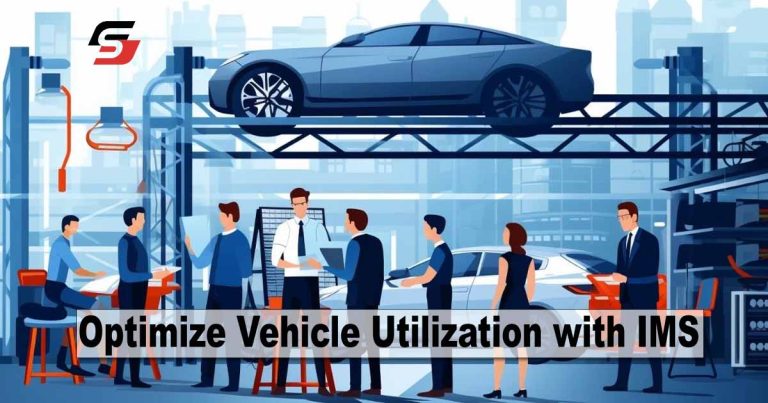Any business that uses cars for daily activities and performs different operations with the help of cars must prioritize effective fleet management. Optimizing automobile utilization can result in substantial value savings and increased productivity for any business, whether handling a fleet of company vehicles, a transport service, or a transportation corporation. Fleet inventory control systems, which utilize modern generation and data-driven approaches, provide a powerful solution for this optimization. These systems can track and monitor the location, usage, and maintenance needs of each vehicle in real time. In this guide, we will discuss vehicle utilization with fleet inventory management systems.
The Importance of Vehicle Utilization
Making the most of the resources in your fleet is the key to optimizing vehicle utilization. When your vehicles spend more time on the road serving your business’s core functions. You reduce overhead costs and increase revenue potential. Inactive cars are a waste of money because they use resources and don’t add any value. Scheduling and transport optimization systems optimize vehicle usage by analyzing traffic patterns and delivery locations. And reducing inactive time, and monitoring utilization to identify underutilized vehicles, saving fuel and increasing profitability.
Here, we explain some primary reasons why vehicle utilization is Important.
Cost Savings
You can reduce needless expenditures on maintenance, fuel, insurance, and depreciation by ensuring each vehicle is utilized to its maximum capacity. Optimizing vehicle utilization can reduce labor costs, and improve customer satisfaction. And enhance a company’s reputation by providing timely deliveries and reducing delays.
Environmental Impact
Reducing useless vehicle utilization helps lower carbon emissions, contributing to a greener and extra sustainable operation. Optimizing car usage can also help reduce visitor congestion and enhance air satisfactory in urban regions. Which will reduce traffic and create a healthier atmosphere for all by effectively managing routes and schedules.
Improved Productivity
Efficiently allocated vehicles can increase the number of tasks completed in a given time frame, ultimately enhancing productivity. Optimized vehicle utilization improves resource coordination, eliminates delays, and boosts productivity. Ensuring vehicles are always available, allows businesses to complete tasks efficiently and effectively.
Better Customer Service
Timely and efficient deliveries or services can enhance customer satisfaction and loyalty. Efficient vehicle allocation improves response times customer satisfaction. And reduces late deliveries and missed appointments, leading to positive word-of-mouth referrals and repeat business.
Explain the Fleet Inventory Management Systems
Fleet inventory management systems, sometimes called fleet management software, provide a complete solution for optimizing vehicle utilization. Businesses use vehicle tracking systems to manage their fleet, monitor fuel consumption, maintenance schedules, and driver performance, enhancing efficiency, reducing costs, and optimizing routes for customer satisfaction. These systems provide various features that help organizations streamline their operations and get the most out of their fleet.
Instant Vehicle Tracking
GPS and telematics generation allow for actual-time tracking of motors, permitting managers to screen their location and status, which is critical for green dispatching and routing. Instant seek enhances reaction instances, patron pride, and productivity in organizations. Managers can identify areas for driver behavior improvement and implement targeted training programs.
Maintenance Scheduling
Fleet management software can music vehicle maintenance schedules, making sure that vehicles are in highest quality running circumstance and minimizing downtime because of sudden breakdowns. Fleet control software program helps agencies maintain automobile lifespan, follow regulatory requirements, avoid consequences, and reduce prices by using tracking protection schedules.

Driver Behavior Monitoring
These systems can track driver behavior, including speeding, harsh braking, and idling. Which can help reduce fuel consumption and vehicle wear and tear. Driver behavior monitoring systems provide valuable information about driver performance, safety, and efficiency. Enabling targeted training programs and telematics integration to promote safer driving habits.
Route Optimization
Fleet management software can suggest the most efficient routes for each trip, considering traffic conditions and other factors to minimize travel time and fuel consumption. Fleet management software optimizes routes, reduces vehicle damage, and provides immediate traffic updates, enabling drivers to make informed decisions and avoid unnecessary delays.
Inventory Management
These systems can help businesses with inventory-carrying vehicles optimize their inventory levels and reduce needless trips. Inventory management software helps companies track inventory levels, patterns, and demand, reducing overstocking, fuel consumption, and transportation costs. It provides real-time visibility, enabling efficient fulfilment and avoiding unnecessary trips.
Strategies for Optimizing Vehicle Utilization
Vehicle Right-Sizing
Fleet management systems can help you identify whether your current fleet size is adequate or if you have too many or too few vehicles. Right-sizing your fleet can lead to significant cost savings. Fleet management systems analyze vehicle utilization data to determine optimal vehicle numbers, preventing unnecessary expenses and ensuring efficient customer service.
Dynamic Scheduling
With real-time data on vehicle locations and statuses, you can dynamically assign tasks to the nearest and most available vehicles, reducing idle time. Dynamic scheduling enhances fleet productivity, quickens customer response times, and identifies underutilized vehicles, enabling better resource allocation and potentially reducing vehicle requirements.
Preventive Maintenance
Regularly schedule and perform preventative maintenance based on vehicle utilization information to keep your fleet in pinnacle circumstance and avoid sudden breakdowns. Monitoring car usage data can optimize preservation schedules, decrease downtime, increase fleet lifespans, reduce costs, and improve safety by way of implementing preventive upkeep packages.
Driver Training
Use data on driver behavior to identify areas for improvement and implement training programs to encourage safe and efficient driving. Fleet managers can identify additional training areas by analyzing driver behavior data and implementing programs to promote safer driving practices, reduce accidents, and enhance fleet efficiency.

Data Analysis
Analyze historical data on vehicle usage and costs to identify trends and areas for improvement. Historical data analysis helps fleet managers identify efficiency improvements, optimize routes, reduce fuel consumption, and minimize maintenance costs, enabling informed decisions on vehicle replacement or upgrades.
Sum Up
Optimizing vehicle utilization is a vital part of efficient fleet management. Fleet inventory management systems provide organizations with the tools and insights to make data-driven decisions that enhance productivity, reduce costs, and contribute to sustainability. Your company can optimize its fleet resources and improve both customer satisfaction and profitability by putting these systems into existence and implementing the strategies discussed in this blog post. To move your fleet toward a more profitable and efficient future, accept technology and data-driven aproaches.

